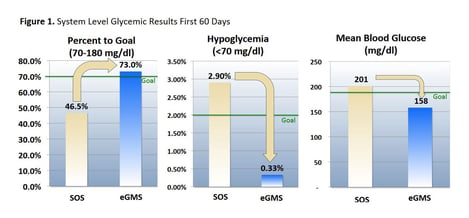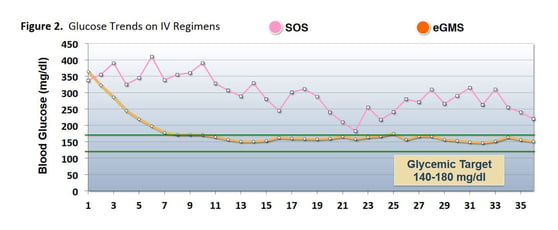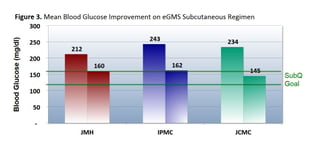Presentation
American Diabetes Association Scientific Sessions
Date
June 2014
Authors
Raymie McFarland,1 Tamera Parsons,2 Randall Ball,2 Amy Henderson,1 Andrew Rhinehart2
Objective
In the last few years, there has been an increased awareness of the importance of inpatient glycemic management and its connection to patient outcomes. Glucose control has been a challenge for hospitals throughout the country, and naturally it has been no different at Mountain States Health Alliance despite the great efforts of our clinicians. There is growing acceptance of the fact that paper protocols and static electronic order sets can only do so much. The options for making significant and sustainable improvements have been limited until now. Given the great implications to our patients, as well as the changing reimbursement environment, we studied the effectiveness of the (eGMS) eGlycemic Management System compared with our Standard Order Sets (SOS) for the treatment of patients with hyperglycemia. At the core of eGMS is Glucommander, a computerized insulin dosing software for IV and SubQ insulin dosing regimens.
Methods
This 60 day quality initiative was conducted on patients using IV and SubQ insulin regimens at 3 hospitals in the MSHA Health System: Johnston Memorial Hospital (JMH), Indian Path Medical Center (IPMC), and Johnson City Medical Center (JCMC), with 135, 189, and 610 beds, respectively. Prescribers on study units had the choice to use eGMS or SOS for patients needing IV or SubQ insulin treatment for hyperglycemia. Patient blood glucose values were recorded and measured according to predetermined hyperglycemia and hypoglycemia outcome metrics. The metrics included: Percent of blood glucose values in the glycemic goal (70-180 mg/dl), percent of hypoglycemia occurrences (<70 mg/dl) with a goal of less than 2%, and mean blood glucose reduction.
Results
Patients on SOS regimens had 46.5% of blood glucose values within the glycemic goal (70-180 mg/dl) while patients on eGMS regimens achieved 73% in goal P< 0.03, representing a 57% overall improvement. Patients on SOS had a 2.9% hypoglycemia rate (<70 mg/dl) while eGMS patients had a 0.33% hypoglycemia rate P <0.002, an 89% improvement. The mean blood glucose achieved for patients on SOS was 201 mg/dl while the average blood glucose for patient on eGMS was 158 mg/dl, a 27% improvement. The average mean blood glucose for all patients on eGMS Glucommander SubQ was within the goal range (<180 mg/dl) across all 3 hospital sites. The average reduction was 73 mg/dl per patient for a 27% improvement.
Conclusion
Patients on eGlycemic Management System came into the prescribed target range quickly, safely and maintained glycemic control, whether they were in the ICU or medical/surgical floors. The glycemic management results at MSHA suggest standardized patient control for IV and SubQ; regardless of prescribing specialty using eGMS. Our results suggest that eGMS is a safe and efficacious tool for improving glycemic patient care and increases a hospital’s performance of reaching glucose targets using both IV and SubQ algorithms compared to Standard Order Sets (SOS).
Affiliations
- Glytec, Greenville, South Carolina.
- Mountain States Health Alliance, Johnson City, Tennessee.


